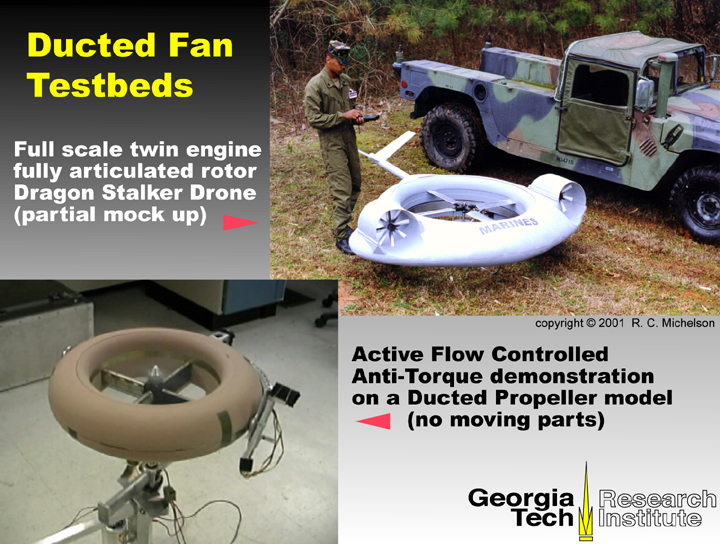The Traffic Surveillance Drone project has received initial funding from the Georgia Department of Transportation and the Federal Highway Administration's Priority Technology Program. Aspects of this ducted fan drone are currently under development within the Georgia Tech Research Institute’s Advanced Vehicle Development and Integration Laboratory. It is designed around an aluminum chassis with a carbon composite body structure that also provides structural stability. It is the first rotary wing drone with twin engines and one-engine-out flight capability. It is designed with affordability and safety in mind. All propulsors are shrouded and the single-rotor design improves reliability while reducing weight and keeping the projected production price in a range that is attractive to law enforcement agencies, emergency search and rescue teams, as well as highway departments.
Present research centers on ways to reduce the size of the drone and to use advanced active flow control techniques to eliminate the need for a fully articulated rotor (replacing it with a fan or propeller) while at the same time obviating the need for deflector vanes. The following picture shows one of our active flow control experiments to demonstrate counter torque while using an unarticulated ducted propeller without deflector vanes (no moving control surfaces). A 7MB movie of the “Bagel” active flow control experiment shows purely acoustic control of antitorque in a ducted fan without the use of deflector vanes. Other experiments demonstrate that pitch and roll can be similarly controlled. In the movie, note that the test stand-mounted vehicle is allowed to completely twist under the effects of propeller torque until it hits the yaw stops on the test stand. A tone can then be heard (emitted by the vehicle under test) and the torque effects are completely neutralized

The Drone also has capabilities that make it attractive for military applications, especially in low intensity conflicts and urban warfare . Note that such a drone would fill a needed void in locations such as Sarajevo where high altitude reconnaissance from assets such as Predator only provide the “"big picture” from above, but do not allow one to look into windows, fly into parking decks, breach obstacles, or perch on a building roof as a sentry. A militarized version of the drone known as Dragon Stalker (see below) has been conceived and mocked up to illustrate its portability in the battlefield. A powered wind tunnel model has been constructed to verify flight envelope analyses.

Robert Michelson Principal Research Engineer, Emeritus - Georgia Tech Research Institute Adjunct Associate Professor (Ret.) - Georgia Institute of Technology President - Millennial Vision, LLC